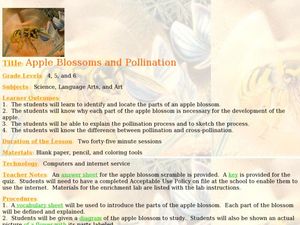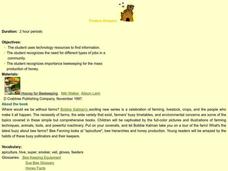Curated OER
Darwin’s Bees
What do you call a bee born in May? A maybe! This first instructional activity in a series of four begins with a starter activity to get scholars thinking about the topic. Then a circus, or circuit of seven activities, show Darwin's...
Curated OER
Placing Artificial Domiciles to Attract Bumble Bees
Students investigate how to entice bumble bees to accept artificial domiciles. They conduct research about bee biology and nest architecture, plan and construct an artificial domicile to attract bumble bee queens, and monitor and record...
Curated OER
The Disappearing Honeybees: Tracking Honeybee Decline
Learners practice graphing and other math skills to track number of honeybee colonies present in United States since 1978, discuss major crops that are dependent on insect pollinators, and examine reasons for decline of United States...
Curated OER
Buzzing Bee's Wardrobe
Students investigate the anatomy of honeybees. In this anatomy instructional activity, students research the physical characteristics of bees and discover what they do. Students create a model of a honeybee showing the correct anatomy.
Curated OER
Plants And Pollination
Students describe sexual reproduction in plants, including the process of pollination, how insects assist in pollination, and how pollination differs from fertilization. They also explore the importance of honey bees to Arizona agriculture.
Curated OER
Apple Blossoms and Pollination
Students explore the concept of pollination. In this pollination activity, students examine the parts of an apple blossom and then compare and contrast pollination and cross-pollination.
Curated OER
Pollination Parties!
Students conduct research on a specified plant and how it is pollinated. For this pollination lesson, students discover how bees pollinate plants and make life better for humans. After completing research, individuals compile a class...
Curated OER
What Bees Eat
Students study plant and animal interdependence by studying bees and pollination. In this interdependence lesson, students discuss flower parts and dissect it to show its reproductive parts. Students then use tissue and pipe cleaners to...
Curated OER
Fish and Flowers
Students read and discuss a research article that explains the unlikely link between increased fish populations and increased plant pollination. They answer reading guide questions to discover this ecological relationship.
Curated OER
Honey Bees!
Students research and complete two assignments about honeybees. Students draw and color a picture of a flower with a honeybee inside of it. Students write a letter to the executives at Ridit Pest Control persuading them to stop the...
Curated OER
Honeybees are Vanishing
Young scholars decide if they agree with a series of statements about the bee population, then read a news article about the disappearance of millions of U.S. honeybees. In this biology and current events lesson, the teacher introduces...
Curated OER
If the Forests Could TAlk
Third graders research insects using the internet sites provided. They research the role of insects as pollinators for plants, and the impact they have on our ecosystem. They participate in various activities/centers utilizing the facts...
Curated OER
Smarty Plants
Students examine plants and pollinators. In this plant biology lesson, students read The Power of Pollinators and identify the parts of the plant and the pollinators. Students design their own imaginary plants.
Curated OER
Finders Keepers
Learners explore the career of beekeeping. In this careers lesson, students examine the importance of the beekeeping industry. Learners read stories about beekeepers and write comparisons. Students write a report on beekeepers and the...
Cornell University
Beneficial Insects
A lot of people think of insects as pests. But actually, some insects are beneficial because they get rid of pests! After learning about beneficial insects, class members research given insects to find out if they are pests or predators.
Curated OER
Working Animals
Students examine the need for the humane treatment of animals. In this animal welfare instructional activity, students realize the need for animal welfare, and decide on a service project that will promote it. The instructional activity...
Curated OER
Symbiosis: Help, Hinder or Destroy
Use background information and vocabulary to familiarize your students with the concept of symbiosis and the role agriculture plays in the shared relationship. They then write the vocabulary in their lab books or journals, and read the...
Curated OER
Insects Are Helpful!
Students see that insects do lots good and are very valuable to humans and nature. This is part of an ongoing effort to dispel fears of insects. They rotate through a series of centers that have examples of how insects contribute to our...
Curated OER
Flowering Plants
Students conduct online research to investigate gardening and landscaping tips. They determine how they can help beautify their homes and neighborhoods.




















